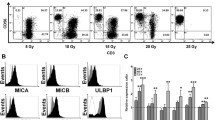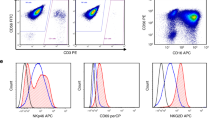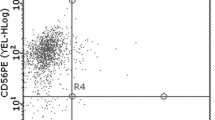Summary
A wide variety of human cancers currently have no effective treatment and are potential targets for lymphokine-activated killer (LAK) cellular immunotherapy. Relapsed acute lymphocytic leukemia (ALL) and neuroblastoma are two of the major therapeutic challenges in pediatric oncology today. However, one problem which makes LAK immunotherapy in children particularly difficult is obtaining the large numbers of cells required. Present adult therapeutic LAK protocols have utilized short-term (5 day) cultures of interleukin-2 (IL2)-activated cells which are initially obtained from leukophersis. Since routine use of this procedure in small children is not practical, we have investigated a different approach to obtain increased cell numbers by activation of peripheral blood mononuclear cells with OKT3, a mitogenic anti-CD3 monoclonal antibody, and IL2. Cell growth and LAK activity in OKT3+IL2-activated cultures were compared to cultures activated with IL2 alone in 2 children with relapsed ALL and 2 children with stage IV neuroblastoma. OKT3+IL2-activated cultures had marked increases in cell number: after 14 days the OKT3+IL2-activated cultures yielded an approximately 500-fold increase in cell number compared to a 7-fold increase for cultures activated with IL2 alone. In vitro 51Cr release assays were used to estimate LAK activity of the cultures at 7 and 14 days. When tested against HL60, a natural killer (NK)-resistant tumor cell line, not only were total cytolytic units greatly increased in OKT3+IL2-stimulated cultures but lytic activity on a per cell basis (lytic units/1×106 cells) had also markedly increased on day 14 of culture. Phenotypic analysis demonstrated that 80% to 90% of cells in OKT3+IL2-stimulated cultures were CD3+ T cells. Variable low percentages of CD16+ NK cells were seen in these cultures. In summary, OKT3+IL2 activation resulted in a large increase in cell yield and the development of high level LAK activity using peripheral blood mononuclear cells from children with cancer. This approach may facilitate the utilization of increased cell numbers in future adoptive immunotherapy protocols, especially in pediatric patients.
Similar content being viewed by others
References
Bluestone JA, Pardoll D, Sharrow SO, Fowlkes BJ (1987) Characterization of murine thymocytes with CD3-associated T-cell receptor structures. Nature 326:82
Coldman A, Fryer C, Elwood JM, Sonley MJ (1980) Neuroblastoma. Influence of age at diagnosis, stage, tumor site and sex on prognosis. Cancer 46:1896
Damle NK, Doyle LV, Bradley EC (1986) Interleukin 2-activated human killer cells are derived from phenotypically heterogenous precursors. J Immunol 137:2814
Main EK, Lampson LA, Hart MK, Kornbluth J, Wilson DB (1985) Human neuroblastoma cell lines are susceptible to lysis by natural killer cells but not by cytotoxic T-lymphocytes. J Immunol 135 (1):242
Durant J (1987) Immunotherapy of cancer. The end of the beginning. New Engl J Med 316:939
Forni G, Giovarelli M (1987) Strategies for cell-mediated immunotherapy of cancer: killing or help? Immunol Today 7:202
Herberman RB, et al. (1987) Lymphokine-activated killer cell activity. Immunol Today 8 (6):178
Landegren U, Andersson J, Wigzell IL (1984) Mechanism of T-lymphocyte activation by OKT3 antibodies. A general model for T-cell induction. Eur J Immunol 14:325
Lanier LL, Weiss A (1986) The presence of Ti(WT31) negative T lymphocytes in peripheral blood and thymus. Nature 324:268
Lanier LL, Worner NL (1981) Paraformaldehyde fixation of hematopoietic cells for quantative flow cytometry (FACS) analysis. J Immunol Methods 47:25
Lanier L, Phillips J, Hacke HJ, Tutt M, Kumar V (1986) Natural killer cells: Definition of a cell type rather than a function. J Immunol 137:2735
Lanier L, Federspeil NA, Ruitenberg JJ, Phillips JH, Allison JP, Littman D, Weiss A (1987) The T cell antigen receptor complex expression in normal peripheral blood CD4− CD8− T lymphocytes. A CD3 associated disulfide linked chain heterodimer. J Exp Med 165:1076
Leo O, Foo M, Sachs D, Samelson LE, Bluestone JA (1987) Identification of a monoclonal antibody specific for a murine T3 polypeptide. Proc Natl Acad Sci USA 84:1374
Main EK, Lampson LA, Hart MK, Kornbluth J, Wilson DB (1985) Human neuroblastoma cell lines are susceptible to lysis by natural killer cells but not by cytotoxic T-lymphocytes. J Immunol 135 (1):242
Malkovsky M, Loveland B, North M, Asherson GL, Gao L, Ward P, Fliers W (1987) Recombinant interleukin-2 directly augments the cytotoxicity of human monocytes. Nature 325:262
Ochoa A, Gromo G, Alter B, Sondel P, Bach F (1987) Long-term growth of lymphokine-activated killer (LAK) cells: role of anti-CD3, B IL-1, interferon-alpha and -beta. J Immunol 138:2728
Ochoa A, Hasz DE, Rezonzew R, Anderson PM, Bach FH (1988) T cells and NK cells develop LAK activity in long term cultures with OKT3+IL2 (submitted)
Rosenberg S (1986) Adoptive immunotherapy of cancer using lymphokine active killer cells and recombinant interleukin-2. In: DeVita V, Hellman S, Rosenberg S (eds) Important advances in oncology, J.B. Lippincott Co., Philadelphia, pp 55
Rosenberg SA, Lotze MT, Muul LM, Chang AF, Avis FP, Leitman S, Line WM, Robertson CN, Lee RE, Rubin JT, Simpson CG, White DE (1987) New Engl J Med 316:889
Salup R, Back T, Wiltrout R (1987) Successful treatment of advanced murine renal cell cancer by bicompartmental adoptive chemoimmunotherapy. J Immunol 138:641
Wawwe JP, DeMey JR, Goossens JG (1980) OKT3: A monoclonal anti-human lymphocyte antibody with potent mito genic properties. J Immunol 124:2708
Author information
Authors and Affiliations
Additional information
Supported by the Children's Cancer Research Fund, and the USPHS Training Grant T32CA09445
Supported by NIH AI17687, AI18326, AI19007, and AI72626
Rights and permissions
About this article
Cite this article
Anderson, P.M., Bach, F.H. & Ochoa, A.C. Augmentation of cell number and LAK activity in peripheral blood mononuclear cells activated with anti-CD3 and interleukin-2. Cancer Immunol Immunother 27, 82–88 (1988). https://doi.org/10.1007/BF00205763
Received:
Accepted:
Issue Date:
DOI: https://doi.org/10.1007/BF00205763




